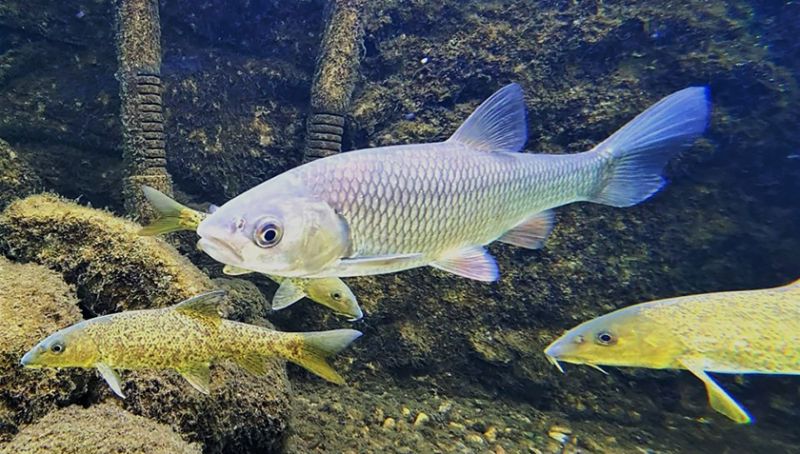Biochemical signatures to predict how chemical pollution endangers biodiversity
It is estimated that between 40,000 and 60,000 chemical substances are in regular circulation worldwide. As the industry continues to expand, vast quantities of pharmaceuticals, detergents, pesticides, and other compounds reach ecosystems every year. This notably concerns Switzerland, one of the world's top five chemical-exporting nations. Assessing a substance’s environmental impact before market approval is essential. Yet until now, forecasting the long-term effects of chemical pollution on the environment, particularly which species are most vulnerable to exposure, has been a challenge.
In a study just published in Environmental International, Eawag researchers now took a new approach to improve such forecasts. They examined how different fish species naturally process and eliminate chemicals from their bodies - an ability that could indicate which species are most likely to survive in polluted environments.
Biotransformation meets biodiversity
“We looked at biotransformation, a process organisms use to convert chemicals into products that can be excreted”, explains Marco Franco, environmental toxicologist and the study’s first author. Collaborating with colleagues from Eawag's fish ecology and environmental chemistry departments, he focused on aquatic ecosystems, which often become reservoirs for environmental pollutants. The team studied five fish species from different locations along Switzerland’s Aare watercourse. "Instead of using traditional methodologies in conservation research, we explored whether cellular processes they have in common could indicate if a species is more or less sensitive to pollution", notes Franco about the scientists’ unconventional approach.
All five species, selected as typical representatives of these regional aquatic communities, shared the same molecular machinery to transform chemicals. However, when analysing their efficiency in using it, the researchers discovered substantial variations. To their initial surprise, the species with the highest activity, hence the most resilient, was the pumpinkseed – an invasive fish in Swiss rivers. “This was unexpected, but it makes sense,” says Franco. “Invasive species need to survive in an unfamiliar and already populated habitat, so being better at coping with potentially toxic compounds gives them an advantage.”
Chemical exposure puts species with low biotransformation capacity at risk
The scientists detected even more striking differences depending on the regions where fish were sampled. Individuals from areas near agricultural or industrial zones, where pollution levels are higher, showed two to eleven times more chemical-processing activity than those from less disturbed areas.
“This suggests that being exposed to pollutants can increase the animals’ biotransformation activity. It also means that those with a naturally low activity face greater stress, because chemicals accumulate more and the animals have to invest more energy into dealing with them. This makes them more vulnerable to other threats”, explains Franco. In ecosystems composed of many different species, these more sensitive populations are at higher risk of decline. Identifying them early helps design tailored protection strategies.
Implications for chemical market approval
Beyond biodiversity conservation, the study’s findings also open opportunities to improve risk assessment of new chemicals during the market approval process. Current safety considerations rely heavily on data from laboratory animals known as “model” species, which may not accurately reflect wildlife sensitivity. “The key question is whether the animals and plants we aim to protect are actually more or less sensitive to a given chemical than such model species”, stresses Franco.
The approach he used offers a promising solution. “Our approach links biochemical data to ecosystem-wide predictions. That means that by measuring the biotransformation activity of a wild species and comparing it to the model data, we can determine whether a chemical is actually more or less harmful for animals in their natural environment.” This will allow to integrate real-world ecological information into regulatory decisions.
Reducing animal testing in environmental research
The method underlying this study also reduces the need for animal testing in environmental research. Instead of large-scale studies tracking many animals over time, the biochemical signature approach uses data from a few individuals to assess species' sensitivity to chemical pollution. This is possible because the analyses focus on markers at the cellular level, allowing scientists to extract meaningful data from small sample sizes rather than relying on large population studies.
The researchers nevertheless emphasize that field validation is essential. “Ultimately, we need to monitor ecosystems over time to confirm our predictions and see how species populations evolve in a given ecosystem”, concludes Franco. Meanwhile, his team is confident that their approach can be applied widely across different geographical areas to better assess chemical threats to biodiversity.
Biotransformation – a cellular machinery for chemical elimination
Biotransformation is a process in which living organisms, like fish, break down potentially harmful substances into products that can be excreted from the body. This occurs mainly in cells of the liver, the gills, and the gastrointestinal tract, and involves a chain of biochemical reactions. In so-called “phase I” reactions, specialized molecules called enzymes modify the chemical by adding reactive groups that make the chemical more water-soluble and thus easier for the body to handle. Phase II reactions then attach larger molecules to the modified substance, further preparing it for elimination from the body. This process is an essential part of an organism’s “chemical defensome” – a set of biological mechanisms to detect, neutralize, and eliminate harmful substances and protect the organism from toxic outcomes.
